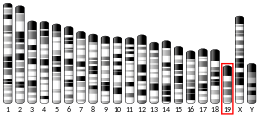PEO1
Twinkle protein is a mitochondrial protein that in humans is encoded by the C10orf2 gene.[5][6][7][8]
Twinkle is a mitochondrial protein with structural similarity to the phage T7 primase/helicase (GP4) and other hexameric ring helicases. The twinkle protein colocalizes with mtDNA in mitochondrial nucleoids, and its name derives from the unusual localization pattern reminiscent of twinkling stars (Spelbrink et al., 2001).[supplied by OMIM][8]
References
- 1 2 3 GRCh38: Ensembl release 89: ENSG00000107815 - Ensembl, May 2017
- 1 2 3 GRCm38: Ensembl release 89: ENSMUSG00000025209 - Ensembl, May 2017
- ↑ "Human PubMed Reference:".
- ↑ "Mouse PubMed Reference:".
- ↑ Spelbrink JN, Li FY, Tiranti V, Nikali K, Yuan QP, Tariq M, Wanrooij S, Garrido N, Comi G, Morandi L, Santoro L, Toscano A, Fabrizi GM, Somer H, Croxen R, Beeson D, Poulton J, Suomalainen A, Jacobs HT, Zeviani M, Larsson C (Jun 2001). "Human mitochondrial DNA deletions associated with mutations in the gene encoding Twinkle, a phage T7 gene 4-like protein localized in mitochondria". Nat Genet. 28 (3): 223–31. PMID 11431692. doi:10.1038/90058.
- ↑ Leipe DD, Aravind L, Grishin NV, Koonin EV (Mar 2000). "The bacterial replicative helicase DnaB evolved from a RecA duplication". Genome Res. 10 (1): 5–16. PMID 10645945. doi:10.1101/gr.10.1.5.
- ↑ Nikali K, Suomalainen A, Saharinen J, Kuokkanen M, Spelbrink JN, Lonnqvist T, Peltonen L (Oct 2005). "Infantile onset spinocerebellar ataxia is caused by recessive mutations in mitochondrial proteins Twinkle and Twinky". Hum Mol Genet. 14 (20): 2981–90. PMID 16135556. doi:10.1093/hmg/ddi328.
- 1 2 "Entrez Gene: PEO1 progressive external ophthalmoplegia 1".
Further reading
- Suomalainen A, Kaukonen J, Amati P, et al. (1995). "An autosomal locus predisposing to deletions of mitochondrial DNA". Nat. Genet. 9 (2): 146–51. PMID 7719341. doi:10.1038/ng0295-146.
- Hirano M, DiMauro S (2003). "ANT1, Twinkle, POLG, and TP: new genes open our eyes to ophthalmoplegia". Neurology. 57 (12): 2163–5. PMID 11756592. doi:10.1212/wnl.57.12.2163.
- Lewis S, Hutchison W, Thyagarajan D, Dahl HH (2002). "Clinical and molecular features of adPEO due to mutations in the Twinkle gene". J. Neurol. Sci. 201 (1–2): 39–44. PMID 12163192. doi:10.1016/S0022-510X(02)00190-9.
- Strausberg RL, Feingold EA, Grouse LH, et al. (2003). "Generation and initial analysis of more than 15,000 full-length human and mouse cDNA sequences". Proc. Natl. Acad. Sci. U.S.A. 99 (26): 16899–903. PMC 139241
 . PMID 12477932. doi:10.1073/pnas.242603899.
. PMID 12477932. doi:10.1073/pnas.242603899. - Arenas J, Briem E, Dahl H, et al. (2003). "The V368i mutation in Twinkle does not segregate with AdPEO". Ann. Neurol. 53 (2): 278. PMID 12557300. doi:10.1002/ana.10430.
- Garrido N, Griparic L, Jokitalo E, et al. (2003). "Composition and Dynamics of Human Mitochondrial Nucleoids". Mol. Biol. Cell. 14 (4): 1583–96. PMC 153124
 . PMID 12686611. doi:10.1091/mbc.E02-07-0399.
. PMID 12686611. doi:10.1091/mbc.E02-07-0399. - Agostino A, Valletta L, Chinnery PF, et al. (2004). "Mutations of ANT1, Twinkle, and POLG1 in sporadic progressive external ophthalmoplegia (PEO)". Neurology. 60 (8): 1354–6. PMID 12707443. doi:10.1212/01.wnl.0000056088.09408.3c.
- Van Goethem G, Löfgren A, Dermaut B, et al. (2004). "Digenic progressive external ophthalmoplegia in a sporadic patient: recessive mutations in POLG and C10orf2/Twinkle". Hum. Mutat. 22 (2): 175–6. PMID 12872260. doi:10.1002/humu.10246.
- Deschauer M, Kiefer R, Blakely EL, et al. (2003). "A novel Twinkle gene mutation in autosomal dominant progressive external ophthalmoplegia". Neuromuscul. Disord. 13 (7–8): 568–72. PMID 12921794. doi:10.1016/S0960-8966(03)00071-3.
- Korhonen JA, Gaspari M, Falkenberg M (2004). "TWINKLE Has 5' -> 3' DNA helicase activity and is specifically stimulated by mitochondrial single-stranded DNA-binding protein". J. Biol. Chem. 278 (49): 48627–32. PMID 12975372. doi:10.1074/jbc.M306981200.
- Ota T, Suzuki Y, Nishikawa T, et al. (2004). "Complete sequencing and characterization of 21,243 full-length human cDNAs". Nat. Genet. 36 (1): 40–5. PMID 14702039. doi:10.1038/ng1285.
- Deloukas P, Earthrowl ME, Grafham DV, et al. (2004). "The DNA sequence and comparative analysis of human chromosome 10". Nature. 429 (6990): 375–81. PMID 15164054. doi:10.1038/nature02462.
- Korhonen JA, Pham XH, Pellegrini M, Falkenberg M (2004). "Reconstitution of a minimal mtDNA replisome in vitro". EMBO J. 23 (12): 2423–9. PMC 423294
 . PMID 15167897. doi:10.1038/sj.emboj.7600257.
. PMID 15167897. doi:10.1038/sj.emboj.7600257. - Wanrooij S, Luoma P, van Goethem G, et al. (2004). "Twinkle and POLG defects enhance age-dependent accumulation of mutations in the control region of mtDNA". Nucleic Acids Res. 32 (10): 3053–64. PMC 434440
 . PMID 15181170. doi:10.1093/nar/gkh634.
. PMID 15181170. doi:10.1093/nar/gkh634. - Tyynismaa H, Sembongi H, Bokori-Brown M, et al. (2005). "Twinkle helicase is essential for mtDNA maintenance and regulates mtDNA copy number". Hum. Mol. Genet. 13 (24): 3219–27. PMID 15509589. doi:10.1093/hmg/ddh342.
- Hudson G, Deschauer M, Busse K, et al. (2005). "Sensory ataxic neuropathy due to a novel C10Orf2 mutation with probable germline mosaicism". Neurology. 64 (2): 371–3. PMID 15668446. doi:10.1212/01.WNL.0000149767.51152.83.
- Ziebarth TD, Farr CL, Kaguni LS (2007). "Modular Architecture of the Hexameric Human Mitochondrial DNA Helicase". J. Mol. Biol. 367 (5): 1382–91. PMC 2711006
 . PMID 17324440. doi:10.1016/j.jmb.2007.01.079.
. PMID 17324440. doi:10.1016/j.jmb.2007.01.079. - Baloh RH, Salavaggione E, Milbrandt J, Pestronk A (2007). "Familial parkinsonism and ophthalmoplegia from a mutation in the mitochondrial DNA helicase twinkle". Arch. Neurol. 64 (7): 998–1000. PMID 17620490. doi:10.1001/archneur.64.7.998.
This article is issued from
Wikipedia.
The text is licensed under Creative Commons - Attribution - Sharealike.
Additional terms may apply for the media files.




